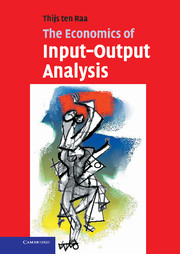Book contents
- Frontmatter
- Contents
- List of figures
- List of tables
- Preface
- Glossary
- 1 Introduction
- 2 Input-output basics
- 3 Multiplier effects
- 4 Linear programming
- 5 Are input-output coefficients fixed?
- 6 The System of National Accounts
- 7 The construction of technical coefficients
- 8 From input-output coefficients to the Cobb–Douglas function
- 9 The diagnosis of inefficiency
- 10 Input-output analysis of international trade
- 11 Environmental input-output economics
- 12 Productivity growth and spillovers
- 13 The dynamic inverse
- 14 Stochastic input-output analysis
- Solutions to exercises
- Index
- References
7 - The construction of technical coefficients
Published online by Cambridge University Press: 18 December 2009
- Frontmatter
- Contents
- List of figures
- List of tables
- Preface
- Glossary
- 1 Introduction
- 2 Input-output basics
- 3 Multiplier effects
- 4 Linear programming
- 5 Are input-output coefficients fixed?
- 6 The System of National Accounts
- 7 The construction of technical coefficients
- 8 From input-output coefficients to the Cobb–Douglas function
- 9 The diagnosis of inefficiency
- 10 Input-output analysis of international trade
- 11 Environmental input-output economics
- 12 Productivity growth and spillovers
- 13 The dynamic inverse
- 14 Stochastic input-output analysis
- Solutions to exercises
- Index
- References
Summary
Introduction
Technical coefficients were defined in chapter 2 as the input requirements (amounts of commodities) per unit of output (for each commodity). The technical coefficients for output 1 were written in a column vector, (2.1), and placement of all the “recipes” next to each other yields the matrix of technical coefficients, (2.2). The matrix of technical coefficients is a function of the input and output data of the economy, which were presented in section 6.4. For every pair of a use and a make table, (U, V), we face the task of constructing the associated matrix of technical coefficients: A(U, V). It is important to distinguish a function, such as A, and a value it can take, A(U, V). A value is a matrix of technical coefficients that is associated with a given pair of data. The function itself represents the association or the rule by which the coefficients are constructed. The latter is the topic of this chapter.
If there are as many commodities as production units and the make table, V, is a diagonal matrix, the situation is simple. Every sector would use an input vector, a column of U, and make a single output.
- Type
- Chapter
- Information
- The Economics of Input-Output Analysis , pp. 87 - 98Publisher: Cambridge University PressPrint publication year: 2006
References
- 1
- Cited by



